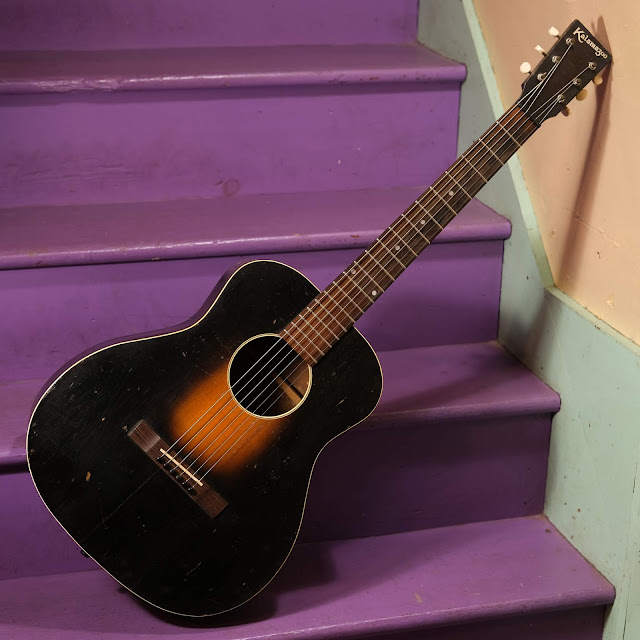1934 Gibson-made Kalamazoo KG-11 Flattop Guitar
Update 2020: the owner of this since 2017 is consigning this as he's got the itch for a good banjo -- his loss! At any rate, I've updated the photos, added a video clip, and updated the description here and there to reflect its current state (the same as when it left, actually). Now back to my original description...
I really enjoy KG-11s and, considering that there's always a few more of them to be repaired around here, that's good news for me! A customer selected this from the bunch on-hand, and now that repairs are done, it just needs to settle-in and then will be cleared for shipping.
I really enjoy KG-11s and, considering that there's always a few more of them to be repaired around here, that's good news for me! A customer selected this from the bunch on-hand, and now that repairs are done, it just needs to settle-in and then will be cleared for shipping.
This one has a factory order number of 1171 on the neckblock which states that it's a 1934 build -- though the small sunburst and straight-cut headstock sort-of call it out as a Kalamazoo made in the "first batch" of 1933-34, anyway. It shares the usual KG-11 specs -- a 1 3/4" nut, usual Gibson 24 3/4" scale length, 14 3/4" lower bout, and a "squashed" body with a lower-on-the-bout bridge as compared to the more-iconic KG-14s. These design changes compared to the KG-14 push the nut closer to the left hand, impart an overall woodier, warmer tone, and locate the body in a super-comfortable way in the lap. The sacrifice is a small bit of volume and punch, but for my playing style I tend to prefer KG-11s most of the time as they're a more forgiving guitar -- something a friend of mine also concluded after giving it a whirl right after I'd finished work on it.
This has a 3-piece, solid spruce top. The back, sides, and neck are solid mahogany and the fretboard is Brazilian rosewood with a 12" radius. The tuners are replacements, but the ferrules are originals. Note the original ebony nut. I add side dots standard, these days. The pearl dots and smallish Gibson frets are original, though. I love the look of these pickguard-less early models.
The original bridge would've been Brazilian rosewood with a through-cut saddle slot and "ebonized" black with a nitro finish sprayed over it. My replacement is Indian rosewood and has a drop-in saddle slot for ease-of-use and stability's sake. The tuners are 1950s units I'm used to seeing on Harmony guitars.
This has a 3-piece, solid spruce top. The back, sides, and neck are solid mahogany and the fretboard is Brazilian rosewood with a 12" radius. The tuners are replacements, but the ferrules are originals. Note the original ebony nut. I add side dots standard, these days. The pearl dots and smallish Gibson frets are original, though. I love the look of these pickguard-less early models.
The original bridge would've been Brazilian rosewood with a through-cut saddle slot and "ebonized" black with a nitro finish sprayed over it. My replacement is Indian rosewood and has a drop-in saddle slot for ease-of-use and stability's sake. The tuners are 1950s units I'm used to seeing on Harmony guitars.
Repairs included: a neck reset, fret level/dress (thankfully on an already-straight neck), side dots install, replacement rosewood bridge, bone saddle cut from the remains of the original, a couple of crack repairs/cleats (a couple to the side at the bass waist and one on the top below the bridge), and replacement bridge pins.
Setup notes: it has a straight neck, frets with life left in them, and plays bang-on-the-dot at 3/32" EA and 1/16" DGBE low to high. I originally strung it with phosphor bronze in 11s, but currently it's wearing D'Addario nickel bronze in what feels like 11s, too. The heaviest set I suggest for standard tuning on these guitars is a mixed one -- 52w, 38w, 28w, 22w, 16, 12. This guitar has been very stable, however -- it came back playing exactly on spec just as it'd left 3 years ago.
Condition notes: replacement tuners, repaired crack at bass-side-waist and one hairline repair below the bridge on the top, general mix of scratches and small scuffs throughout and the usual weather-checking patterns to the finish throughout as well, replacement bridge and bridge pins. The finish is all-original and has no overspray/touch-ups.
Setup notes: it has a straight neck, frets with life left in them, and plays bang-on-the-dot at 3/32" EA and 1/16" DGBE low to high. I originally strung it with phosphor bronze in 11s, but currently it's wearing D'Addario nickel bronze in what feels like 11s, too. The heaviest set I suggest for standard tuning on these guitars is a mixed one -- 52w, 38w, 28w, 22w, 16, 12. This guitar has been very stable, however -- it came back playing exactly on spec just as it'd left 3 years ago.
Scale length: 24 3/4"
Nut width: 1 3/4"
String spacing at nut: 1 9/16"
String spacing at bridge: 2 3/16"
Body length: 17 1/4"
Lower bout width: 14 3/4"
Waist width: 9"
Upper bout width: 9 7/8"
Side depth at endpin: 4"
Side depth at endpin: 4"
Top wood: solid spruce
Back/sides wood: solid mahogany
Bracing type: ladder
Fretboard: Brazilian rosewood
Bridge: rosewood replacement, original (modified) bone saddle
Neck feel: med-big V-shape, ~10" board radius
Condition notes: replacement tuners, repaired crack at bass-side-waist and one hairline repair below the bridge on the top, general mix of scratches and small scuffs throughout and the usual weather-checking patterns to the finish throughout as well, replacement bridge and bridge pins. The finish is all-original and has no overspray/touch-ups.
















Comments
Thanx.